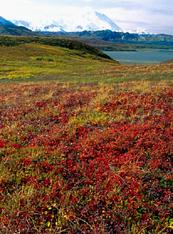|
Arctic
Tundra: Plants
Plants need warmth
and sunlight to grow and reproduce. In the Arctic tundra, warmth
and sunlight are in short supply, even in the summer. The ground
is frequently covered with snow until June, and the Sun is always
low in the sky.
Only plants with shallow
root systems grow in the Arctic tundra because the permafrost prevents
plants from sending their roots down past the active layer of soil.
The active layer of soil is free from ice for only 50 to 90 days.
Arctic plants have a
very short growing season. However, in spite of the severe conditions
and the short growing season, there are approximately 1,700 kinds
of plants that live in the Arctic tundra. Some of the plants that
live in the Arctic tundra include mosses, lichens, low-growing shrubs,
and grasses--but no trees. In fact, "tundra" is a Finnish words
which means "treeless".
Plant
Adaptations
 Growing
close together and low to the ground are some of the adaptations
that plants use to survive. This growing pattern helps the plant
resist the effects of cold temperatures and reduce the damage caused
by the impact of tiny particles of ice and snow that are driven
by the dry winds. Photo © 2000-www.arttoday.com Growing
close together and low to the ground are some of the adaptations
that plants use to survive. This growing pattern helps the plant
resist the effects of cold temperatures and reduce the damage caused
by the impact of tiny particles of ice and snow that are driven
by the dry winds. Photo © 2000-www.arttoday.com
Plants also have adapted
to the Arctic tundra by developing the ability to grow under a layer
of snow, to carry out photosynthesis in extremely cold temperatures,
and for flowering plants, to produce flowers quickly once summer
begins. A small leaf structure is another physical adaptation that
helps plants survive. Plants lose water through their leaf surface.
By producing small leaves the plant is more able to retain the moisture
it has stored.
Back
| Next
|











